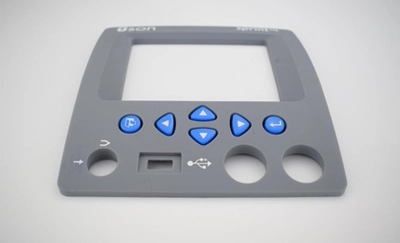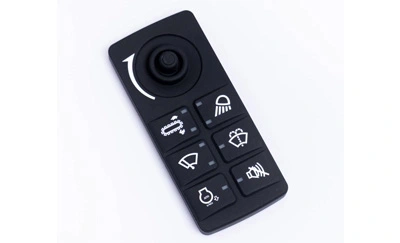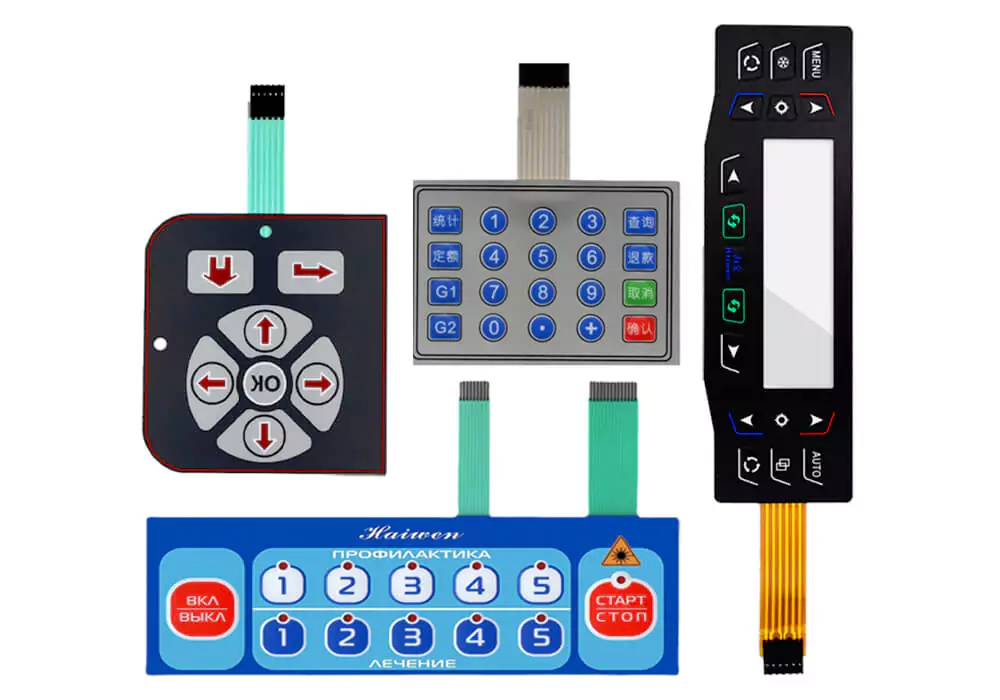The Manufacturing Process Behind Membrane Switch Over: What You Required to Know
The production process behind membrane changes combines careful style, product choice, and quality assurance. It starts with recognizing the intricacies of membrane layer button design and proceeds through different stages, consisting of product selections and printing methods. Each stage plays a necessary role in making sure functionality and toughness. The intricacies of layer construction and the extensive screening standards may expose understandings that are not immediately evident. What exists beyond these foundational aspects?
Recognizing Membrane Layer Change Design
Membrane layer switches might appear straightforward at first glance, their style entails intricate considerations that ensure performance and longevity. The design procedure begins with a complete understanding of individual demands, including the interface's desired application and ecological aspects. Ergonomics is a crucial element, as the format must facilitate ease of usage while making certain that responsive responses satisfies individual expectations.Moreover, the layering of parts, such as visuals overlays, sticky layers, and conductive traces, should be precisely crafted. membrane switch. This split setup not only influences the switch's responsiveness yet additionally affects its durability. Attention is provided to the securing methods utilized to safeguard versus dampness and dust, which might endanger performance. In addition, design considerations reach appearances, where shade plans and aesthetic quality improve customer experience. Inevitably, the design of membrane layer switches over equilibriums capability, user experience, and durability, ensuring that they fulfill the needs of various applications effectively
Products Made Use Of in Membrane Layer Switch Production
When selecting products for membrane switch production, it is necessary to consider both efficiency and toughness. The primary products include polyester and polycarbonate movies, which provide versatility and toughness. These movies are usually coated with sticky to guarantee appropriate bonding to substratums. Conductive inks, usually composed of silver or carbon, are critical for creating electric links within the switch, enabling trusted operation.Additionally, a safety layer, such as a difficult layer, is regularly applied to boost scrape resistance and longevity. The choice of backing material, such as acrylic or foam, can substantially impact the button's responsive feeling and overall individual experience. In addition, different ecological aspects, including temperature level and moisture, must direct product option to guarantee peak performance in particular applications. Inevitably, the ideal mix of products adds to the membrane switch's functionality and life expectancy, making informed options necessary for makers.
The Printing Process: Creating Video and Text
The printing procedure in membrane layer switch manufacturing plays a significant function in generating top quality graphics and message. Different visuals layout strategies are utilized to guarantee aesthetic appeal and performance, while mindful ink option techniques are important for durability and efficiency. Comprehending these elements is fundamental for achieving best cause membrane button design.
Graphic Design Techniques
Graphic layout strategies play a vital function in the printing process of membrane buttons, as they define exactly how graphics and message will ultimately appear on the end product. Effective graphic design includes the strategic use layouts, colors, and font styles to improve readability and aesthetic charm. Designers often make use of vector graphics for scalability, making certain that images stay sharp at various sizes. Additionally, interest to comparison and positioning is essential, as it affects user communication and visual top quality. The unification of branding components, such as logo designs, must be handled with care to maintain brand name stability. Overall, thoughtful graphic layout strategies add significantly to the performance and attractiveness of membrane layer switches, impacting customer experience and product efficiency.
Ink Option Techniques
Choosing the ideal ink is vital for accomplishing the preferred aesthetic quality and sturdiness in membrane layer button manufacturing. Numerous ink kinds are utilized, consisting of solvent-based, water-based, and UV-curable inks. Each kind uses unique qualities, such as flexibility, attachment, and resistance to environmental elements. Solvent-based inks are commonly favored for their durability and dynamic colors, while water-based inks are a lot more ecologically pleasant however might have restrictions in attachment. UV-curable inks give fast treating and robust efficiency. Additionally, shade matching techniques assure that the chosen inks align with layout specifications. Eventually, the selection of ink have to take into consideration aspects such as application technique, substratum compatibility, and end-use demands to accomplish remarkable cause membrane layer switch graphics and message.
Layer Building And Construction and Assembly

Product Option Refine
A mindful selection of products is crucial in the manufacturing procedure of membrane switches, as it directly influences performance and resilience. The key materials made use of include polyester, polycarbonate, and various conductive inks. Polyester is often preferred for its outstanding resistance to chemicals and abrasion, making it appropriate for severe settings. Polycarbonate, on the various other hand, gives remarkable quality and influence resistance, which is helpful for applications calling for presence and robustness. Conductive inks, generally made up of silver or carbon, are vital for creating reliable electrical pathways. In addition, the option of sticky materials influences the total integrity of the button - membrane switch. Reviewing factors such as ecological direct exposure, tactile responses, and visual demands overviews manufacturers in choosing the very best materials for their particular applications
Layer Adhesion Methods
Sticking layers in membrane button construction is an important process that guarantees capability and long life. Numerous attachment methods are utilized to protect ideal bonding between layers, which generally include using adhesives, warm, and stress. Pressure-sensitive adhesives (PSAs) are commonly made use of for their simplicity of application and immediate bonding abilities. Additionally, thermal bonding methods can be applied, where warmth is utilized to turn on sticky residential properties, securing a strong bond. The option of bond approach mainly depends on the products involved and the details application needs of the membrane layer button. Correct alignment and uniform application of adhesives are essential to prevent issues, safeguarding the switch runs effectively throughout its designated life-span.
Quality Assurance Measures
Ensuring quality assurance during the layer building and setting up of membrane buttons is necessary for keeping performance and integrity. This process generally involves several important actions, consisting of complete inspections at each phase of manufacturing. Producers use sophisticated screening techniques, such as peel examinations and attachment assessments, to verify the integrity of layer bonds. Additionally, visual inspections are performed to determine any kind of flaws in printing or material disparities. Environmental problems, such as temperature level and humidity, are meticulously monitored to guarantee suitable healing and attachment. In addition, routine calibration of equipment aids maintain exact production requirements. By carrying out these quality find here assurance steps, suppliers can greatly reduce the threat of product failure, ensuring that the last membrane layer switches over fulfill the needed specifications and client expectations.
Examining and Quality Assurance Actions

Advancements in Membrane Switch Over Modern Technology
As innovations in technology continue to develop, membrane switches are gaining from cutting-edge growths that boost their performance and individual experience. One significant innovation is the combination of capacitive touch innovation, which enables for even more intuitive and receptive individual interfaces. This change not just improves appearances yet also decreases mechanical deterioration, prolonging the lifespan of the switches.Additionally, improvements in visuals overlay materials have actually brought about enhanced resilience and resistance to ecological elements such as dampness and UV light. These materials now supply boosted clarity and illumination, additional boosting the aesthetic appeal.Furthermore, the consolidation of clever modern technology is transforming membrane layer switches right into interactive control board, allowing connectivity with IoT gadgets. This connectivity fosters a seamless customer experience, leading the way for applications in various industries, from health care to consumer electronics. Collectively, these advancements position membrane switches over as crucial parts in modern-day device layout.
Regularly Asked Inquiries
How Long Does the Membrane Switch Production Process Take?
The period of the membrane switch manufacturing process can vary substantially. Aspects such as complexity, products utilized, and production volume impact timelines, with common production varying from a few days to a number of weeks for completion.
What Are the Usual Applications for Membrane Layer Buttons?
Membrane layer buttons are commonly utilized in numerous sectors, consisting of automotive controls, family home appliances, medical tools, and consumer electronic devices (membrane switch). Their versatility and longevity make them ideal for applications requiring user-friendly user interfaces and reliable efficiency in varied atmospheres
Can Membrane Switches Over Be Custom-made for Specific Needs?

What Is the Lifespan of a Typical Membrane Change?
The life expectancy of a regular membrane switch varies, however usually, it ranges from 1 to 5 million cycles. Factors such as use, setting, and worldly top quality considerably affect resilience and overall performance over time.

Are Membrane Layer Changes Eco-friendly?
The ecological friendliness of membrane layer switches differs. Some materials made use of might not be recyclable, while others can be environment-friendly. The general effect relies on producing practices and products, demanding mindful factor to consider during option and disposal. The production procedure behind membrane switches combines mindful layout, material option, and quality control. It starts with recognizing the complexities of membrane switch layout and progresses through various phases, including material options and printing methods. When choosing products for membrane button production, it is necessary to contemplate both efficiency and toughness. A mindful selection of products is crucial in the manufacturing procedure of membrane switches, as it straight influences functionality and durability. The option of bond technique mostly depends on the materials entailed and the certain application demands of the membrane layer switch.